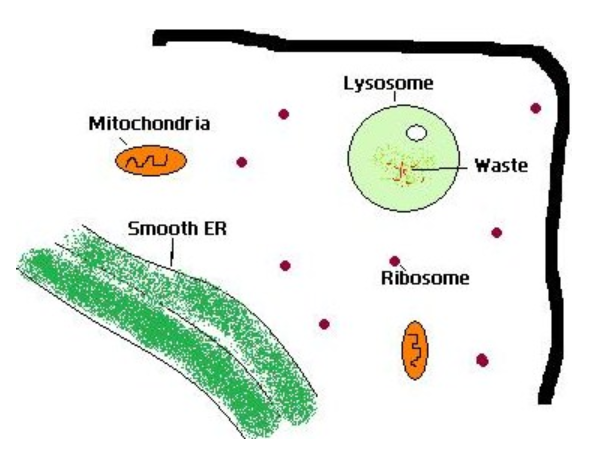
The hydrolytic enzymes are found in:
A. Peroxisomes
B. Lysosomes
C. Lomasomes
D. None of these
Answer
480k+ views
Hint: Hydrolytic enzymes exist in the form of minute crystalline or semicrystalline granules. Sizes of these granules vary from 5-8 nm. These are digestive enzymes and need an acidic medium to perform thier function. Hence, these enzymes are also called acid hydrolases.
Complete step-by-step answer:
1. Lysosomes are the small vesicle-like organelles found solely in eukaryotic cells. They contain many hydrolytic enzymes such as proteases, nucleases, and lipases.
2. In prokaryotes, there are no membrane-bound organelles. Hence lysosomes are absent, but the hydrolytic enzymes are present in the cytoplasm along with inclusion bodies.

3. Their function is to breakdown cellular wastes and debris by engulfing and breaking down with hydrolytic enzymes. Apart from breaking down biological polymers, lysosomes are also involved in various other cell processes such as counting discharged materials, energy metabolism, cell signaling (communication processes that govern basic activities of cells and coordinate multiple-cell actions), and restoration of the plasma membrane.
4. The pH level of the lumen of lysosome lies between 4.5 and 5.0, which is acidic.
5. Lysosomes are also known as suicide bags of the cell because their digestive enzymes may also damage the lysosomes themselves, and this can result in cell death. This is termed as autolysis.
So, the correct answer is “Option B Lysosomes”.
Note:
1. Peroxisomes (also known as a microbody) are membrane-bound organelles, found in the cytoplasm of almost all of the eukaryotic cells. They are oxidative organelles and they frequently use molecular oxygen as a co-substrate, to form hydrogen peroxide ($H_2O_2$). This helps/ defends the cell from dangerous free radicals and other powerful oxidative substances.
2. Lomasomes are para mural bodies that are continuous with the cell wall. They (para mural bodies) are membranous or vesicular structures located between the cell walls and cell membranes of plant and fungal cells. Para mural bodies are referred to as Plasmalemmasomes if they are associated with the plasmalemma.
Complete step-by-step answer:
1. Lysosomes are the small vesicle-like organelles found solely in eukaryotic cells. They contain many hydrolytic enzymes such as proteases, nucleases, and lipases.
2. In prokaryotes, there are no membrane-bound organelles. Hence lysosomes are absent, but the hydrolytic enzymes are present in the cytoplasm along with inclusion bodies.

3. Their function is to breakdown cellular wastes and debris by engulfing and breaking down with hydrolytic enzymes. Apart from breaking down biological polymers, lysosomes are also involved in various other cell processes such as counting discharged materials, energy metabolism, cell signaling (communication processes that govern basic activities of cells and coordinate multiple-cell actions), and restoration of the plasma membrane.
4. The pH level of the lumen of lysosome lies between 4.5 and 5.0, which is acidic.
5. Lysosomes are also known as suicide bags of the cell because their digestive enzymes may also damage the lysosomes themselves, and this can result in cell death. This is termed as autolysis.
So, the correct answer is “Option B Lysosomes”.
Note:
1. Peroxisomes (also known as a microbody) are membrane-bound organelles, found in the cytoplasm of almost all of the eukaryotic cells. They are oxidative organelles and they frequently use molecular oxygen as a co-substrate, to form hydrogen peroxide ($H_2O_2$). This helps/ defends the cell from dangerous free radicals and other powerful oxidative substances.
2. Lomasomes are para mural bodies that are continuous with the cell wall. They (para mural bodies) are membranous or vesicular structures located between the cell walls and cell membranes of plant and fungal cells. Para mural bodies are referred to as Plasmalemmasomes if they are associated with the plasmalemma.
Recently Updated Pages
The correct geometry and hybridization for XeF4 are class 11 chemistry CBSE

Water softening by Clarks process uses ACalcium bicarbonate class 11 chemistry CBSE

With reference to graphite and diamond which of the class 11 chemistry CBSE

A certain household has consumed 250 units of energy class 11 physics CBSE

The lightest metal known is A beryllium B lithium C class 11 chemistry CBSE

What is the formula mass of the iodine molecule class 11 chemistry CBSE

Trending doubts
State the laws of reflection of light

Arrange Water ethanol and phenol in increasing order class 11 chemistry CBSE

One Metric ton is equal to kg A 10000 B 1000 C 100 class 11 physics CBSE

Difference Between Prokaryotic Cells and Eukaryotic Cells

A mixture of o nitrophenol and p nitrophenol can be class 11 chemistry CBSE

How do I convert ms to kmh Give an example class 11 physics CBSE




